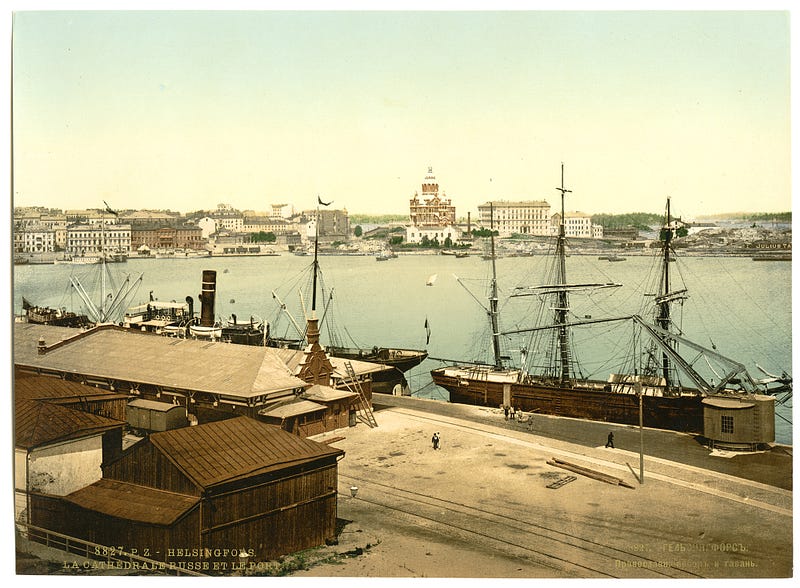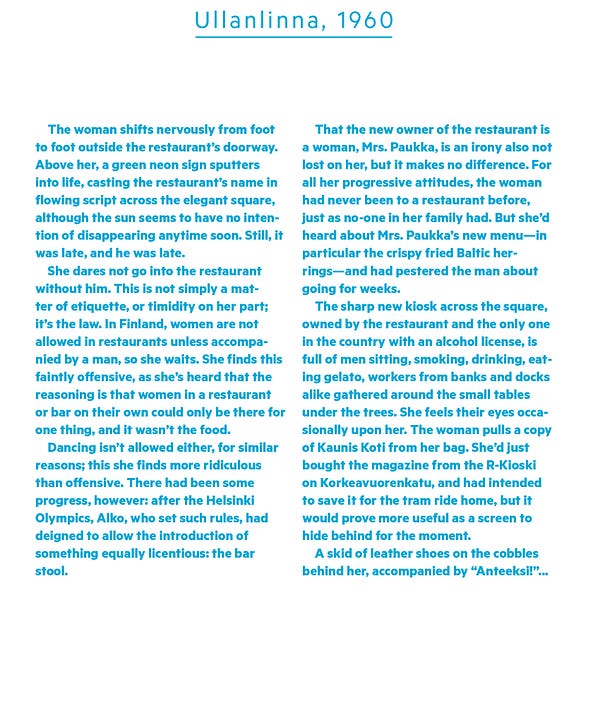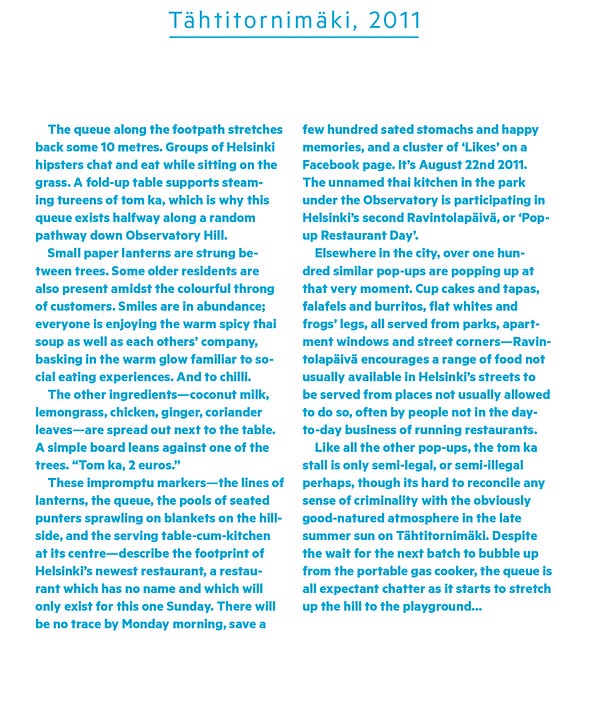
Setting the scene for a strategic design project about food culture
A while ago, we (Sitra’s Strategic Design Unit) released a book on Helsinki’s street food culture, which, taken with a liberal pinch of salt, covers the last 150 years or so of food in the city.
It is part of our background research, and network creation, for what would become Open Kitchen, our strategic design project in this area.
It ends with the currently burgeoning food scene in the city, as exemplified by the culinary insurgency movements of Ravintolapäivä — covered here — and the temporary incursion of the ‘Camionette’ crêpes van at Kamppi last summer—described here.
Our short book goes into more detail on the emergence and significance of those very recent events, but also puts them in a context of Finnish history and culture, and particularly Helsinki’s history. As Helsinki is a youngish city, we took its relevant food history to date back to a first ‘golden age’ of food culture as a trading post and military base under Swedish and Russian rule, and then fast forward through the straitjacket constraints of the freshly-minted Finnish national identity after independence in 1917, via the constriction of prohibition in the 1920s, pausing briefly on the severe war years before basking in the temporary liberalisation of the 1952 Olympics.
We then pick our way through the complex social mores of the 1950s and ‘60s — which started with women not being allowed into restaurants on their own; nor barstools for that matter — before the emergence of fast food and cheap air travel leads to another expansion and contraction, through the late twentieth century, into the ‘New Nordic Cuisine’ of recent years.


In some ways, the history of food holds up a mirror to the history of the country, which indicates what fundamental cultural patterns and industrial and political systems we’re dealing with when we look at food. Which is exactly why we’re interested in it, of course.
We asked a few smart locals to help with the book — thanks to Ville Tikka and Nupu Gaivert, Tea Tönnov, Kaarle Hurtig, and many others who were interviewed for the book. Archive photos were carefully selected from Lehtikuva (not a great service but there’s a great archive in there somewhere), US Library of Congress (the source of the wonderful hand-coloured prints of old Helsinki) and many others.

These sit alongside contemporary photo-essays, including Hurtig’s visceral ‘Night on the Town’ series.
Boyer and I then ended up designing and writing the book. (See this related entry on using print-on-demand for work-in-progress and design choices.) We took too long on production, of course, which is a problem with self-imposed deadlines, but that means I can share some layouts that didn’t make it, including a single-word pull-quote style I saw in The Wire magazine, and rather liked, but was probably a little avant-garde for this purpose. Besides, ultimately we had to incorporate the Low2No brand.


Why we made the book
Firstly, and probably least importantly, we like to make things. We like to explore formats, to make our often abstract work concrete (or at least paper) in some useful way.
Secondly, the self-imposed need to make the book served as the ‘Macguffin’ that drove us to immerse ourselves in food history, Helsinki’s food culture, its relevant institutions, the sphere of our project more broadly. (More on identifying and using Macguffins here.)
And thirdly, as a physical artefact, it serves as a kind of token to open doors, start conversations.
The kind of conversations strategic design engages in often concern what we call dark matter, which is shorthand for the organisational culture, legislation, regulatory environment, intellectual property issues; the imperceptible material or substrate which either enables or blocks.
So we’re interested in street food not in order to get good falafals on Helsinki’s street corners — though that would be nice! — but because food is such a productive area for understanding systems; systems of culture, systems of production and consumption, systems of governance and so on.
This book, and associated activity, set the scene, and to some extent prepared the ground for Open Kitchen, the project that we would ultimately design and deliver in this area. You can read more about that here.
Food is something that everyone has to address, in both qualitative and quantitative senses, several times a day. It is at once cultural, social, economic, physical, digital, industrial, political, and so on. It is about what are streets can be used for, and who decides that. It’s about our health, our wealth, our understanding of cultural diversity. it’s about industries, logistics, and supply chains. It’s directly about sustainability and climate change, as well as social innovation and wellbeing, community formation, individual free will, identity formation, class, entrepreneurship and more besides.
It could hardly be more fundamental.
We’re particularly interested in street food, or ‘everyday food’, as a productive way of exploring cultural diversity in Helsinki. It carries the seeds of a more diverse Helsinki, and so could be incredibly useful.
So this book is partly just a tangible summation of some of our early research, but it’s also a clear statement of why food is such an interesting perspective from which to better understand and shape cities. We’ve been working with, and around, the City of Helsinki for over a year now, constantly discussing the ideas explored towards the end of the book, and things are beginning to change. Not because of our efforts, as the city has witnessed several amazing other initiatives in this area, which we detail in the book. But the book may have helped a little (though traceability of impact in this area remains almost impossible.)
You can download a PDF here, or order a physical copy from Lulu. (The latter is recommended; note: we’re not making any money on the Lulu books; as Sitra, we can’t really accept it!)
Setting the scene
Finally, I experimented with the writing a little, producing four ‘super-short stories’ to set the scene.
In some sense, they’re a formal counterpoint to photoessays at the end. Yet in retrospect, this also felt a little like the 14 Cities series I produced while at Arup. It was also influenced by having read Diego Marani’s extraordinary novel New Finnish Grammar just beforehand. The evocative writing in that book is worth around ten history books on Finland during the Winter Wars, and I wanted to balance the ‘deliberately academic-lite’ research with something a little more open to interpretation and allusion. (Drawn from a vague and distant understanding I have of Kristeva’s ideas about the short story as a more open form of text.)
The stories also have a little of the scenarios produced in the Low2No workbook — they sort of work as an equivalent of that here, almost a ‘strategic design fiction’. But they’re written to be a little more ambiguous, perhaps, trying to capture what is both simultaneously good and bad about Helsinki street food culture. It’s also not the kind of thing that the recipients of this book — policymakers, for instance — are used to reading in this context.
(I’ve learned that if you want to change the content and tenor of a strategic conversation, or if the outcome you’re looking for might be a radical change to established practices, you have to use every conceivable cue — such as formats, language and environments — in order to signal this change, even subconsciously. If policymakers are used to getting the output of Microsoft Word or Powerpoint, or receiving material via a standard report template, or used to meeting in a particular space in a particular way, then you might well have to change all of those things. You’re looking to subtly jolt the audience out of established habits, practices and behaviours, they will tend to lead only to previously established outcomes.)
Hence four short stories to open the book.




They were fun to write and, as a kind of verbal sketching, they helped me frame the rest of the text a little, and get into character. I thought they might work well either interspersed in the text, a kind of punctuation within the overall narrative, or as an amuse-bouche to clear the palette (I resisted food references this far, only to fall at the last.)
We decided to open with them, to set the scene. I’ve reproduced them below. The first is most obviously inspired by Diego Marani’s New Finnish Grammar, though hardly holds a candle to that work. The 1960 vignette is are drawn from documentary research records. The 2011 episode is a depiction of pre-Ravintolapäivä food culture, inspired by stories from our intrepid photographer, Kaarle Hurtig, whereas the last is fairly true representation of the streets on a Ravintolapäivä day.

Esplanadi, 1938
Snow falls softly on Esplanadi, dulling the noise from a passing truck. German soldiers are heading north, fresh off the SS Ariadne passenger steamer puffing smoke into the cold night air at as it sits in the South Harbour.
The bar at the Kämp Hotel is warm, noisy and packed by comparison, full of journalists, academics, politicians, wealthy industrialists and their wives, and what is still a relatively new breed in Finland: international tourists here to see the ‘Daughter of the Baltic’. There is much chatter about the rumour that Greta Garbo has been seen vacationing in the Åland Islands. It’s early evening. Cigarette smoke curls around the bar. Helsinki’s bourgeoisie are picking at canapés to accompany their cocktails, vol-au-vents prepared by the hotel’s French cooks.
Across the grass and gravel promenade outside Kämp, the glass terrace of the Savoy restaurant glows golden in the dark sky. Savoy is a year old and still the talk of the town. The restaurant had been architect Alvar Aalto’s first commission in Helsinki, designed as a jewel to top the ‘Industrial Palace’ building. A liveried black porter welcomes in well-heeled members of the Helsinki set, shuttling to and fro in a series of small elevators from ground floor to the birch-veneered interiors above. The menu is also French-inspired, but peppered with the first dashes of a Finnish fine cuisine: boiled halibut with hollandaise sauce; smoked salmon with spinach.
Down below Savoy, a man sways on a street corner, his hat and heavy overcoat casting a bulky shadow across the snow as he glugs pontikka from a bottle. The prohibition act had been rescinded in Finland a few years earlier, but years of illegal distilling of pontikka has left a healthy — or unhealthy — surplus of lethal home-brew on the market. He draws a few admonishing glances from the elegant ladies chattering in the doorway of Kämp, of which he is entirely oblivious.
The snow falls…


Ullanlinna, 1960
The woman shifts nervously from foot to foot outside the restaurant’s doorway. Above her, a green neon sign sputters into life, casting the restaurant’s name in flowing script across the elegant square, although the sun seems to have no intention of disappearing anytime soon. Still, it was late, and he was late.
She dares not go into the restaurant without him. This is not simply a matter of etiquette, or timidity on her part; it’s the law. In Finland, women are not allowed in restaurants unless accompanied by a man, so she waits. She finds this faintly offensive, as she’s heard that the reasoning is that a woman in a restaurant or bar on her own could only be there for one thing, and it wasn’t the food.
Dancing isn’t allowed either, for similar reasons; this she finds more ridiculous than offensive. There had been some progress, however: after the Helsinki Olympics, Alko, who set such rules, had deigned to allow the introduction of something equally licentious: the bar stool.
That the new owner of the restaurant is a woman, Mrs. Paukka, is an irony also not lost on her, but it makes no difference. For all her progressive attitudes, the woman had never been to a restaurant before, just as no-one in her family had. But she’d heard about Mrs. Paukka’s new menu — in particular the crispy fried Baltic herrings — and had pestered the man about going for weeks.
The sharp new kiosk across the square, owned by the restaurant and the only one in the country with an alcohol license, is full of men sitting, smoking, drinking, eating gelato, workers from banks and docks alike gathered around the small tables under the trees. She feels their eyes occasionally upon her. The woman pulls a copy of Kaunis Koti from her bag. She’d just bought the magazine from the R-Kioski on Korkeavuorenkatu, and had intended to save it for the tram ride home, but it would prove more useful as a screen to hide behind for the moment.
A skid of leather shoes on the cobbles behind her, accompanied by “Anteeksi!”…

Kallio, 2011
The death threat is both unlikely and entirely expected. It’s also to be taken seriously. But not too seriously. It comes with the territory, after all. The photographer engages in light-hearted if careful conversation with the very drunk man who claims to have previously killed at least two people. Sitting down, the conversation meanders slowly away from homicide, to life on the street in general. The photographer relaxes a little, and his camera continues to surreptitiously take in the scene. All around, a familiar chaos is unfolding. The odd stumbling scuffles flaring out of nowhere, punctuating the raucous backdrop of shouts, leers and intoxicated bravado. People stagger around, faces buried in the folds of white paper clutched to their mouths such that you can’t tell if, or what, they’re vomiting or ingesting. The floor is awash with steadily increasing amounts of greased litter. Some corners of the square attract vomit, others urine. Some mild property damage will follow. Someone will get quite badly hurt.
In the middle stands the grilli, impassive, impenetrable, a robust metal box as if designed to be hosed down, purveying gobbets of impossibly unhealthy, generic processed meat product in various forms and quantities, in turn designed to line the stomach after a long night of drinking. Hot dog sausages, burgers, patties, meat pie — all are essentially the same: meat, salt and fat, supported, if not obscured, by seas of ketchup, mustard and garlic sauce. Delicious, if you’ve been helped into the right state of mind. It’s effectively the only place to get food of any kind on a late Saturday night in Kallio, as it is with all the grillis in town.
The drunk’s eyes roll up into his head, and he slumps backwards against the tree. The photographer moves his camera in as close as he dares, loosing off a couple of shots before he moves on.


Tähtitornimäki, 2011
The queue along the footpath stretches back some 10 metres. Groups of Helsinki hipsters chat and eat while sitting on the grass. A fold-up table supports steaming tureens of tomka, which is why this queue exists halfway along a random pathway down Observatory Hill.
Small paper lanterns are strung between trees. Some older residents are also present amidst the colourful throng of customers. Smiles are in abundance; everyone is enjoying the warm spicy thai soup as well as each other’s company, basking in the warm glow familiar to social eating experiences. And to chilli.
The other ingredients — coconut milk, lemongrass, chicken, ginger, coriander leaves — are spread out next to the table. A simple board leans against one of the trees. “Tomka, 2 euros.”
These impromptu markers — the lines of lanterns, the queue, the pools of seated punters sprawling on blankets on the hillside, and the serving table-cum-kitchen at its centre — describe the footprint of Helsinki’s newest restaurant, a restaurant which has no name and which will only exist for this one Sunday. There will be no trace by Monday morning, save a few hundred sated stomachs and happy memories, and a cluster of ‘Likes’ on a Facebook page. It’s August 22nd 2011. The unnamed thai kitchen in the park under the Observatory is participating in Helsinki’s second Ravintolapäivä, or ‘Pop- up Restaurant Day’.
Elsewhere in the city, over one hundred similar pop-ups are popping up at that very moment. Cup cakes and tapas, falafels and burritos, flat whites and frogs’ legs, all served from parks, apartment windows and street corners — Ravintolapäivä encourages a range of food not usually available in Helsinki’s streets to be served from places not usually allowed to do so, often by people not in the day-to-day business of running restaurants.
Like all the other pop-ups, the tomka stall is only semi-legal, or semi-illegal perhaps, though its hard to reconcile any sense of criminality with the obviously good-natured atmosphere in the late summer sun on Tähtitornimäki. Despite the wait for the next batch to bubble up from the portable gas cooker, the queue is all expectant chatter as it starts to stretch up the hill to the playground…
Download and read ‘Helsinki Street Eats’ via Low2no.org. See also ‘Ravintolapäivä, edible urbanism and civic opportunism’ and ‘An edible urbanism: Ravintolapäivä and food culture in Helsinki’, as well as Open Kitchen, our project in this area. See a set of photos from Ravintolapäivä in 2012. A broader discussion of these themes is covered in my short book ‘Dark Matter & Trojan Horses: A Strategic Design Vocabulary’. This piece originally published at cityofsound.com on August 13, 2012.

Leave a comment